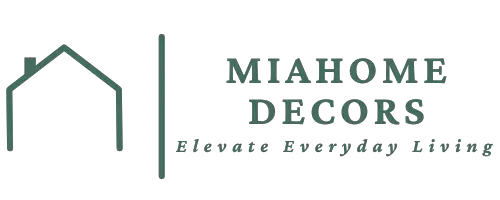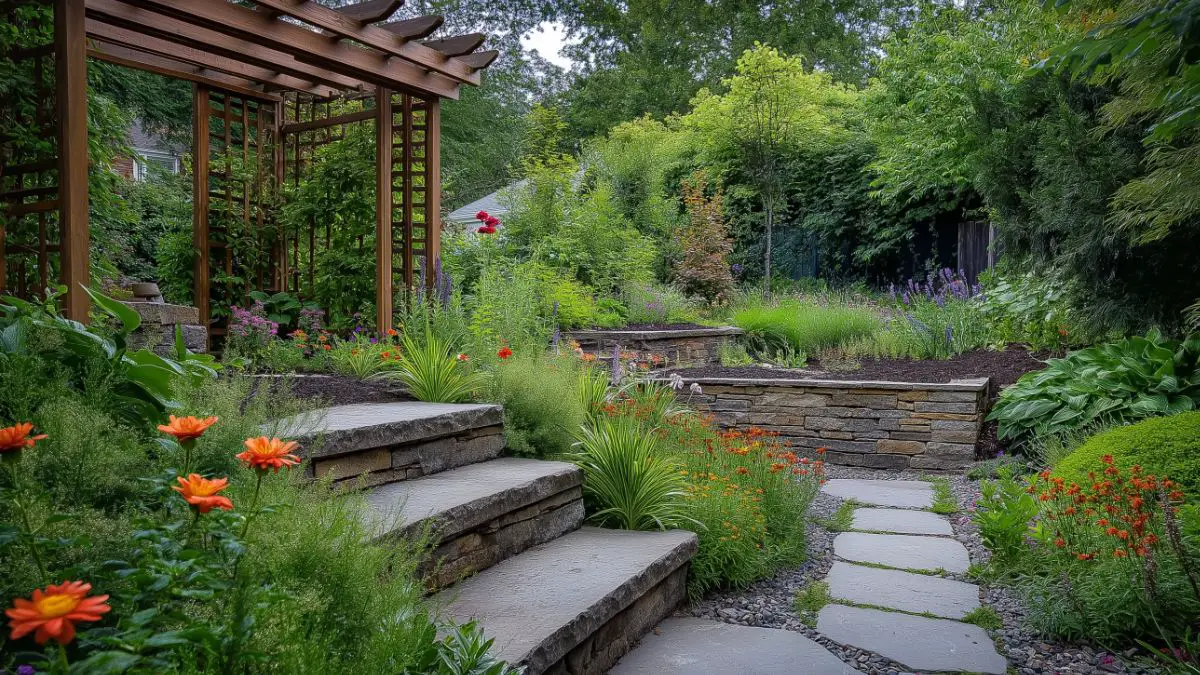Transform Your Outdoor Space with Creative Landscape Design Ideas for a Stylish Yard
Table of Contents
Introduction
Your outdoor space is more than just a backyard—it’s an extension of your home and your lifestyle. Whether you’re dreaming of cozy garden nooks or structured modern patios, great design can completely transform your landscape into a space that’s beautiful, livable, and uniquely yours.
According to the American Society of Landscape Architects, well-designed outdoor spaces can boost home value by 15–20%. But beyond resale potential, thoughtful landscaping enhances how you experience your home—offering relaxation, visual appeal, and functionality in every season.
And the best part? You don’t need to be a professional to design something special. With the right inspiration and a few smart decisions, you can create a yard that feels curated, cohesive, and custom—no matter your budget or square footage.
In this post, we’ll explore creative landscape design ideas that blend beauty with function. From layering textures and defining zones to using lighting and focal points, these concepts will help you elevate your outdoor space into a destination. Whether you’re updating a tiny patio or refreshing a full backyard, you’ll find easy-to-implement tips that make a lasting impact.
In-Depth Outline
1. Define Outdoor Zones for Function and Flow

- Break your yard into clear zones: dining, lounging, gardening, play.
- Use hardscaping (pavers, gravel) to visually separate areas.
- Incorporate different seating types to support various activities.
- Add pergolas, trellises, or planters as natural dividers.
- Design around lifestyle: do you entertain? Garden? Relax?
H3: How to Separate Zones Visually
- Contrast flooring materials (stone vs grass).
- Use outdoor rugs, lighting, or color schemes.
- Plant hedges or ornamental grasses as soft partitions.
H3: Example Layout for Small Yards
- Zone 1: Bistro table + gravel pad
- Zone 2: Lounge chairs on pavers
- Zone 3: Planter bed against a fence
Table: Outdoor Zones and Their Purpose
| Zone Type | Key Elements | Ideal Size (Small Yard) |
|---|---|---|
| Dining | Table, shade, lighting | 8′ × 8′ |
| Lounge | Chairs, fire pit, side tables | 10′ × 10′ |
| Garden | Raised beds, path, tool storage | 4′ × 8′ |
2. Use Layers and Levels for Texture and Interest
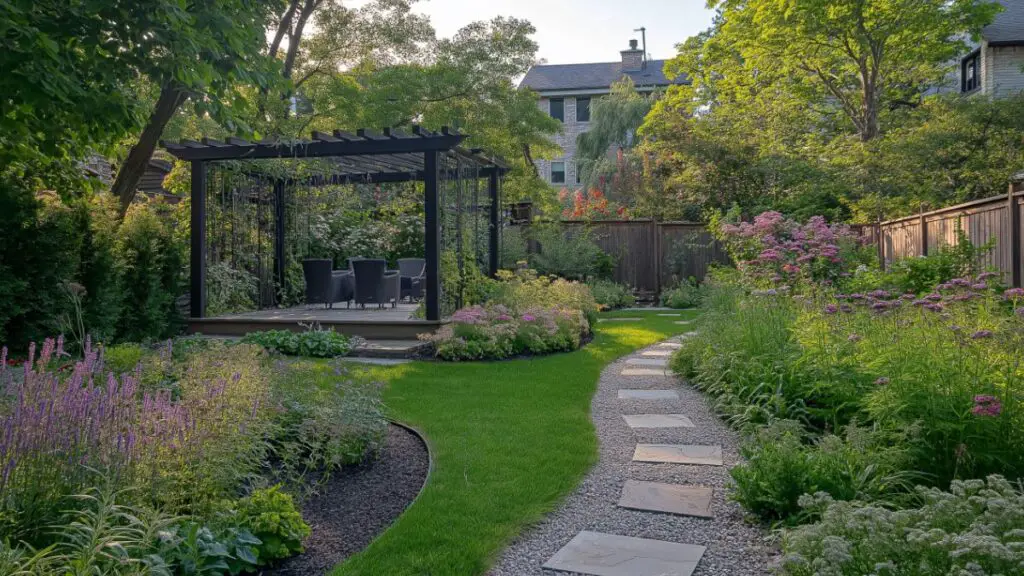
Flat landscapes can feel dull, but layering your design adds richness and dimension—even on a budget. Playing with height, depth, and perspective is key to a high-end look.
Add Vertical Interest
- Install trellises with climbing plants (clematis, jasmine, ivy).
- Use tall planters and sculptural shrubs to create height.
- Hang wall planters or vertical herb gardens on fences or exterior walls.
Create Depth with Layered Planting
- Tall: Trees or shrubs for structure (e.g., boxwood, ornamental grasses).
- Medium: Flowering perennials like lavender, echinacea, or salvia.
- Low: Ground covers like creeping thyme, sedum, or moss.
Play with Levels
- Add raised beds or sunken patios to create elevation.
- Build retaining walls with stone or timber for both function and form.
- Incorporate steps or terracing if your yard has natural slope.
Table: Layered Planting Formula
| Height Level | Plant Suggestions | Best Use Location |
|---|---|---|
| Tall | Hydrangea, arborvitae, bamboo | Back border or privacy screen |
| Medium | Coneflower, sage, agapanthus | Front of tall plants or walkways |
| Groundcover | Thyme, mondo grass, sedum | Path edges or between pavers |
By layering foliage and levels, you guide the eye naturally through the space—making small yards appear larger and large ones feel more curated.
3. Create a Focal Point in Every Zone
- Add a fire pit, water feature, sculpture, or bold planter as a centerpiece.
- Use lighting or framing plants to draw attention to the feature.
- In garden areas, focal points can be arbors or birdbaths.
- In dining spaces, centerpieces or statement lighting fixtures work well.
- Make sure the focal point is visible from multiple angles.
H3: Focal Point Design Tips
- Choose something proportional to the space.
- Surround with complementary textures (e.g., stone + wood).
- Anchor it with symmetry or contrast.
Table: Focal Point Examples by Zone
| Zone | Focal Point Suggestion | Visual Effect |
|---|---|---|
| Lounge Area | Fire pit or chiminea | Warm, social atmosphere |
| Garden Zone | Sculptural trellis | Vertical drama |
| Entry Pathway | Oversized ceramic planter | Welcome statement |
4. Maximize Space with Smart Furniture Choices
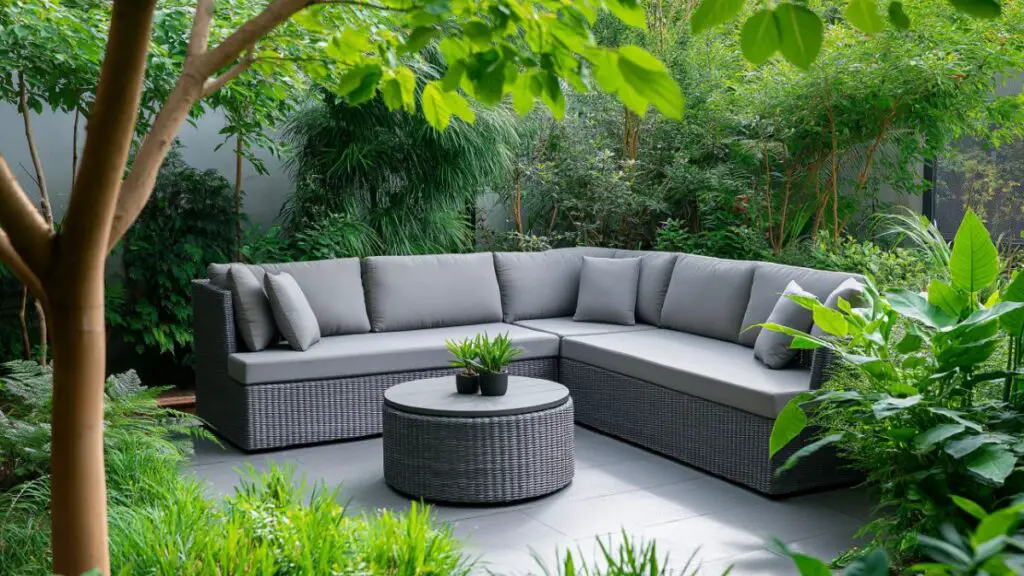
- Choose modular or foldable outdoor furniture for small patios.
- Add built-in benches or seat walls for compact, multi-use zones.
- Use vertical storage (like wall-mounted racks or shelves) for garden tools or cushions.
- Select neutral, weather-resistant fabrics for longevity.
- Use outdoor poufs, stools, or ottomans as flexible seating.
H3: Small Space Furniture Hacks
- Corner benches with storage underneath
- Bistro tables with foldable chairs
- Nesting side tables for layering without clutter
Table: Smart Outdoor Furniture Solutions
| Furniture Type | Ideal For | Benefits |
|---|---|---|
| Modular sofa | Medium to large patios | Rearranged as needed |
| Storage bench | Entryways or decks | Seating + cushion storage |
| Hanging chair | Small balconies | Visual lightness, comfort |
5. Incorporate Outdoor Lighting for Atmosphere and Safety

- Use solar-powered path lights along walkways or flower beds.
- Hang string lights or festoon lights across pergolas or fences.
- Add spotlights for trees or focal plants.
- Consider lanterns or LED candles for portable ambiance.
- Use motion-activated lights for entries and side yards.
H3: Types of Outdoor Lighting
- Ambient: String lights, wall sconces
- Task: Grill lights, reading lamps
- Accent: Uplighting on trees or art
Table: Lighting Ideas by Purpose
| Light Type | Location Example | Design Effect |
|---|---|---|
| String Lights | Pergola, fence | Cozy, festive |
| Uplighting | Base of tree or sculpture | Dramatic evening views |
| Lanterns | On tables or steps | Soft, portable glow |
6. Add Personal Touches and Seasonal Decor
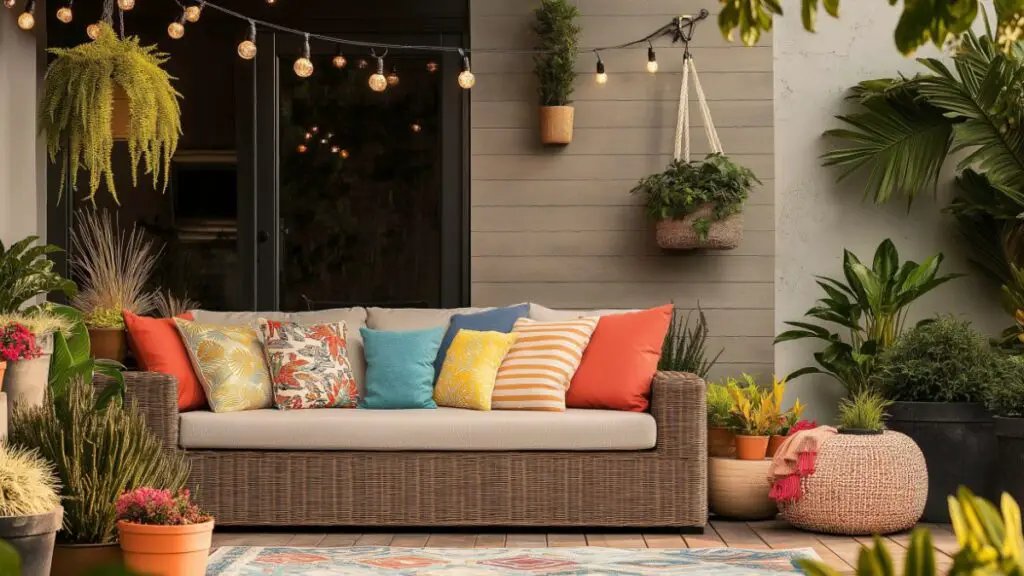
The final layer of landscape design is personal expression. Adding color, texture, and function through accessories can bring your entire space to life.
Ways to Add Personality
- Display ceramic pots, hanging baskets, or painted tiles.
- Use outdoor pillows, rugs, and throws in seasonal colors.
- Add a chalkboard, garden sign, or DIY planter box.
- Incorporate a hammock, swing, or daybed for relaxation.
- Create a small bistro corner for morning coffee or wine at dusk.
Decor Tips by Season
- Spring/Summer: Citrus tones, florals, airy textiles
- Fall/Winter: Rusts, deep greens, flannel, string lights
Table: Personalization Ideas by Accessory Type
| Accessory | Function | Seasonal Swap Suggestion |
|---|---|---|
| Throw Pillows | Color + comfort | Swap covers by season |
| Outdoor Rug | Define space | Use darker tones in fall |
| Planter Decor | Visual layering | Add pine or berries in winter |
Conclusion
With a bit of creativity and thoughtful planning, you can transform your outdoor space into a beautiful, functional retreat. Whether you’re layering plants, defining zones, or styling a cozy lounge area, landscape design doesn’t need to be complicated or costly to make a huge impact.
Start by envisioning how you want to use the space—entertaining, relaxing, gardening—and build around those needs. Add personality with focal points, layered textures, smart furniture, and soft lighting. These touches not only enhance your yard’s aesthetics but also extend your living space into the great outdoors.
By using these creative landscape design ideas, you’ll create a space that feels intentional, welcoming, and uniquely yours—season after season.
